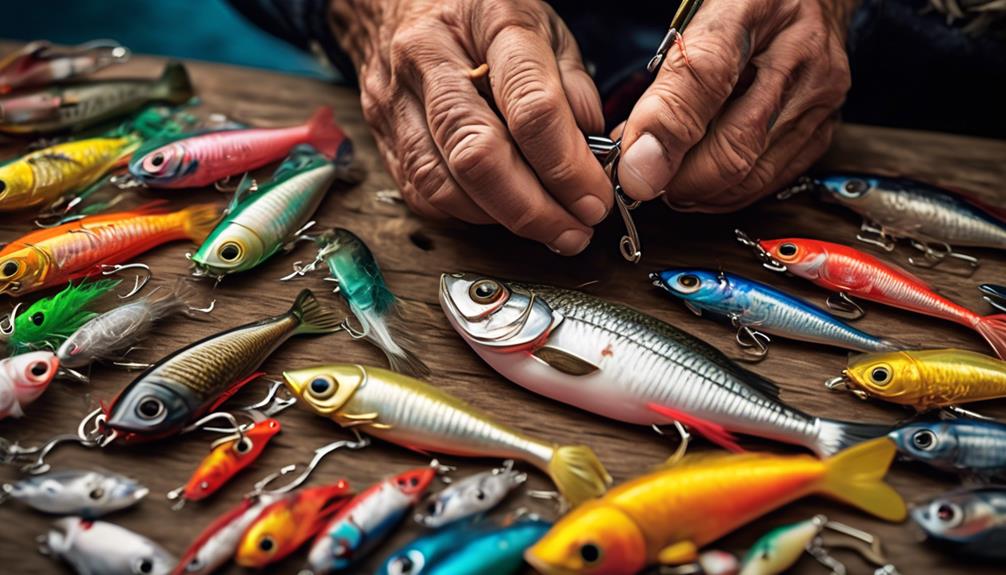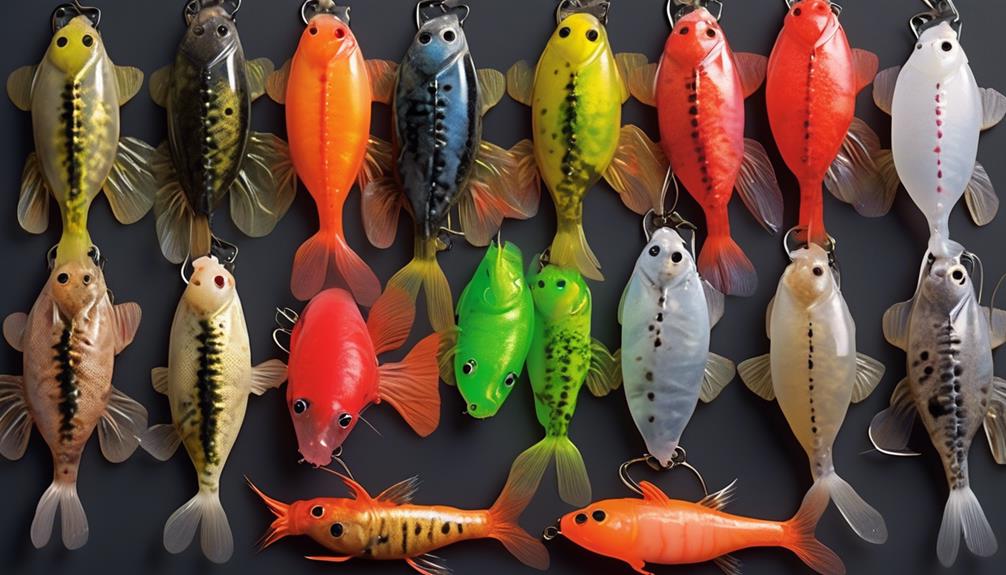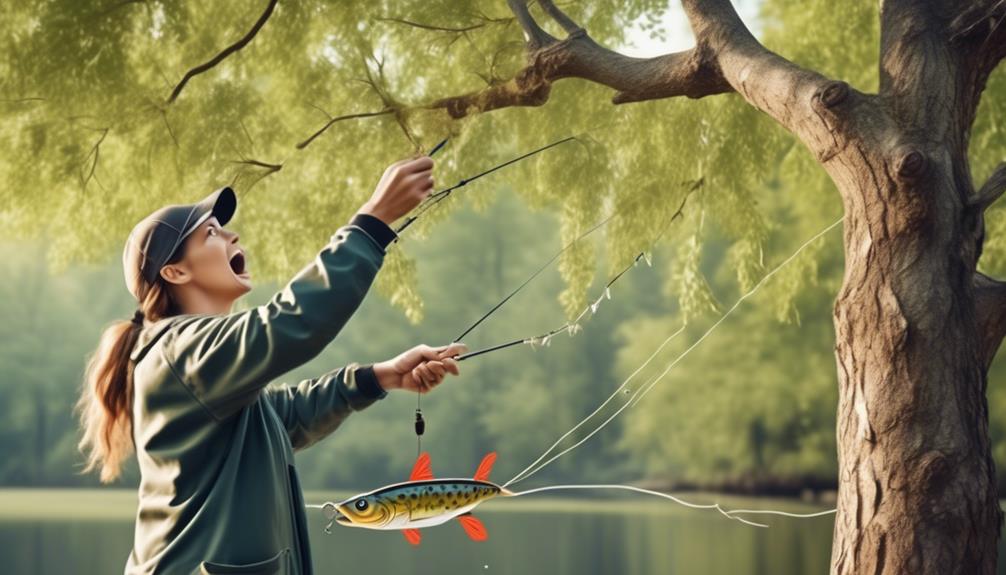When it comes to fishing baits and lures, selecting the right bait can make all the difference in your success on the water.
But it's not just about choosing the right bait; it's also about understanding lure presentation, mastering live bait techniques, utilizing artificial lures effectively, perfecting the art of fly fishing, enhancing lure action and movement, exploring soft plastic bait tactics, and adapting to changing conditions.
Whether you're a seasoned angler or just starting out, there's always something new to learn when it comes to the art of bait and lure fishing.
Selecting the Right Bait
When selecting the right bait for fishing, consider the type of fish you're targeting and the natural prey in their environment. Bait selection is crucial and varies with seasonality. Different bait types and techniques work best at different times of the year.
In spring, for example, fish are more active and tend to feed on smaller, more natural prey. This is when using live bait like worms, minnows, or insect imitations can be highly effective.
As the weather warms up and summer sets in, fish become more aggressive and may go after larger prey. This is when using larger artificial baits such as crankbaits, spinnerbaits, or topwater lures can yield great results.
In autumn, fish tend to feed voraciously in preparation for the upcoming winter. This is a great time to use natural bait like crayfish, as they're a staple in many fish diets during this period.
When winter arrives, fish tend to be more lethargic and less likely to chase fast-moving lures. This is when using slow-moving baits like jigs or soft plastics can be the most effective.
Understanding the seasonality of bait selection can greatly improve your chances of a successful fishing trip. By adapting your bait choices to the natural behavior of the fish, you can increase your chances of a good catch.
Understanding Lure Presentation
Understanding the proper presentation of your lure is essential for enticing fish to strike and improving your overall fishing success. When it comes to lure presentation, two key factors play a crucial role in attracting fish: lure animation and natural presentation through underwater movement.
Lure animation refers to the way in which you manipulate the lure to mimic the movements of natural prey, such as injured baitfish or fleeing insects. This can be achieved through techniques like twitching, jerking, or reeling at varying speeds to create an enticing and lifelike action. By mastering lure animation, you can effectively grab the attention of nearby fish and provoke strikes.
In addition to lure animation, the natural presentation of the lure's underwater movement is equally important. It's essential to ensure that your lure moves through the water in a way that appears natural to the fish. This involves understanding the behavior of the fish you're targeting and adjusting your presentation to match the movement patterns of their natural prey.
Mastering Live Bait Techniques
To enhance your fishing skills, mastering live bait techniques can significantly increase your chances of attracting fish and improving your overall success on the water. Utilizing live bait requires a different set of skills compared to using artificial lures, but when done correctly, it can be incredibly effective.
Here are some key techniques to master when using live bait:
- Bait Retrieval: When using live bait, it's crucial to understand how to retrieve the bait in a way that mimics natural movements. This may involve letting the bait swim freely or gently guiding it to entice nearby fish. Experimenting with different retrieval speeds and patterns can help you determine what the fish are responding to on any given day.
- Live Bait Placement: Properly placing live bait in the water is essential for attracting fish. Whether you're fishing in a lake, river, or ocean, understanding the water's currents and structures can help you strategically position your live bait where the fish are most likely to be. Additionally, using the right hooks and weights to ensure the bait stays at the desired depth can make a significant difference in your success.
- Observation and Adaptation: Mastering live bait techniques also involves keen observation of fish behavior. Pay attention to how the fish are responding to the live bait and be prepared to adapt your techniques accordingly. This may involve adjusting the depth of your bait, changing the type of live bait you're using, or altering your retrieval methods to better entice the fish. Flexibility and adaptability are key when mastering live bait techniques.
Utilizing Artificial Lures Effectively
You can enhance your fishing success by mastering effective techniques for utilizing artificial lures. One crucial aspect to consider is the lure retrieval. Varying your retrieval speed and style can make a significant difference in attracting different target species. For example, a steady, slow retrieve may entice a cautious bass, while a faster, erratic retrieve might trigger a strike from a predatory pike. Experimenting with different retrieval techniques, such as twitching, jerking, or pausing the lure, can help you determine what works best for the specific species you're targeting.
When utilizing artificial lures, it's essential to understand the behavior and preferences of your target species. Each species has unique feeding habits and responses to different types of lures. For instance, if you're aiming for trout in a river, using a spinner with a lifelike action that mimics natural prey can be highly effective. On the other hand, if you're after saltwater species like redfish, a soft plastic swimbait retrieved slowly along the bottom might yield better results.
To maximize your success with artificial lures, pay attention to the conditions of the environment you're fishing in. Factors such as water clarity, temperature, and the presence of cover can influence the effectiveness of certain lures and retrieval techniques. By adapting your approach to these variables, you can increase your chances of enticing strikes from your target species.
Perfecting the Art of Fly Fishing
Mastering the art of fly fishing requires a deep understanding of the behavior and feeding patterns of your target fish species. To perfect your fly fishing skills, you need to familiarize yourself with the following key aspects:
- Fly Casting Techniques: Mastering various fly casting techniques is crucial for successful fly fishing. Understanding how to execute the basic overhead cast, roll cast, and reach cast will significantly improve your ability to present the fly accurately and delicately to the fish.
- Fly Fishing Gear: Having the right fly fishing gear is essential. This includes a well-balanced fly rod, reel, and line suitable for the type of fishing you intend to do. Additionally, having a selection of flies that mimic the insects and baitfish in the area where you plan to fish is crucial for enticing the fish to bite.
- Fly Fishing Knots: Learning and mastering essential fly fishing knots, such as the improved clinch knot, loop knot, and surgeon's knot, is fundamental for securing your fly to the leader and tippet, ensuring a strong and reliable connection between your line and fly.
Furthermore, exploring different fly fishing destinations can provide invaluable experiences and opportunities to test your skills in diverse environments. Whether it's fishing for trout in pristine mountain streams or pursuing saltwater species in coastal flats, each location offers unique challenges and rewards.
Enhancing Lure Action and Movement
Enhancing lure action and movement contributes significantly to attracting and enticing fish to bite. When it comes to lure retrieval, varying your speed and rhythm can mimic the erratic movements of injured prey, making your lure more appealing to nearby fish. Experiment with different retrieval techniques such as steady reeling, stop-and-go, or twitching to see what elicits the best response from the fish in your area.
Additionally, consider the water depth you're fishing in. If you're fishing in shallow waters, using lures that float or suspend can be highly effective. These lures can imitate the movements of surface insects or injured baitfish, which are often targeted by predatory fish in shallow areas. In deeper water, lures that dive or sink are more suitable as they can reach the desired depth where fish are likely to be located.
Exploring Soft Plastic Bait Tactics

When it comes to enticing fish with your lures, exploring soft plastic bait tactics can offer a versatile and effective approach, particularly in shallower waters where erratic movements can attract predatory fish. Soft plastic baits come in various shapes and sizes, mimicking the appearance and movement of real baitfish, making them a popular choice among anglers.
Here are some proven tactics for maximizing your success with soft plastic baits:
- Soft Plastic Retrieval: Varying your retrieval speed and style can make a significant difference in enticing fish to strike. Experiment with techniques such as steady retrieves, stop-and-go retrieves, and twitching motions to mimic the erratic movements of injured baitfish. This can trigger a predatory response from fish in the area, leading to more strikes.
- Soft Plastic Rigging: Proper rigging is crucial for optimizing the performance of soft plastic baits. Whether you prefer Texas rigging, Carolina rigging, or weightless rigging, the way you rig your soft plastics can affect their action and presentation in the water. Additionally, adjusting the placement of weights and hooks can alter the sinking rate and overall movement of the bait, allowing you to adapt to different fishing conditions.
- Targeting Structure and Cover: Soft plastic baits excel at probing areas with cover and structure, such as submerged vegetation, docks, and rocky outcrops. By carefully working your soft plastics around these features, you can imitate natural forage behavior and increase your chances of attracting nearby fish. Pay close attention to any signs of activity or ambush points, as these areas are prime locations to present your soft plastic baits effectively.
Adapting to Changing Conditions
To successfully adapt to changing conditions when using soft plastic baits, it's essential to remain observant and responsive to shifts in the environment and fish behavior. Adapting strategies to tackle unpredictable elements such as weather conditions and the water environment can significantly improve your fishing success.
When faced with changing weather conditions, such as sudden wind shifts or a drop in temperature, it's crucial to adjust your approach. Fish tend to react differently to these variations, and being attuned to their responses can make the difference between a successful outing and going home empty-handed.
Incorporating adaptable techniques involves paying attention to subtle cues. For example, if you notice fish moving closer to the surface during a sudden rainstorm, it might be beneficial to switch to a topwater soft plastic bait to mimic the natural prey that gets washed into the water. Similarly, if the water clarity changes due to heavy winds stirring up sediment, opting for a more visible or noisy soft plastic bait can help attract fish in these altered conditions.
Adaptability also means being open to trying different soft plastic baits based on the changing environment. If the water becomes murky due to heavy rainfall, using a brightly colored or scented soft plastic bait can increase its visibility and appeal to fish. Additionally, being flexible with your retrieval speed and depth can also play a crucial role in adapting to the evolving conditions.
Frequently Asked Questions
How Can I Ensure the Freshness and Quality of Live Bait When Fishing?
To ensure the freshness and quality of live bait when fishing, store it properly. Keep it in a cool, dark place with plenty of oxygen.
Check for signs of spoilage, like a foul smell or slimy texture.
When choosing bait, consider the size and color that best suits the fishing conditions.
Adjust your techniques for saltwater versus freshwater fishing, and adapt to different weather conditions for successful angling.
Are There Any Specific Techniques for Using Bait and Lures in Saltwater Versus Freshwater Fishing?
When fishing in saltwater versus freshwater, there are a few factors to consider. First, you need to take into account the tidal currents and depth. In saltwater, the tidal currents are usually stronger, so you'll need to adjust your techniques accordingly. This may involve using heavier weights or different casting techniques to ensure your bait or lure stays in the desired location.
Secondly, vary the depth of your bait or lure presentation based on the target species and their behavior in the specific environment. Different fish species prefer different depths, so it's important to adapt your presentation accordingly. This can be done by adjusting your line length or using different types of lures that can be fished at different depths.
What Are Some Tips for Choosing the Right Size and Color of Artificial Lures for Different Types of Fish?
When choosing the right size and color of artificial lures, it's essential to consider the type of fish you're targeting. Matching bait to the fish species increases your chances of success.
For example, larger lures are usually more effective for bigger fish, while smaller lures may be better for smaller fish. Additionally, for color, consider the water clarity and the natural prey of the fish.
These factors play a crucial role in selecting the most suitable lures.
How Can I Effectively Store and Maintain My Fishing Bait and Lures to Extend Their Lifespan?
To properly store your fishing bait and lures, follow these steps:
- Keep them in a cool, dry place to prevent moisture damage.
- Store soft plastic baits separately to avoid them melting or fusing together.
- Ensure proper maintenance by rinsing lures and baits with freshwater after each use to remove salt and debris.
- Allow them to dry completely before storing to prevent mold.
- Finally, organize and label your storage containers for easy access and inventory management.
Are There Any Special Considerations for Fishing in Different Weather Conditions, Such as Rain or Wind?
When fishing in extreme conditions like a rainy day or windy weather, it's important to adjust your techniques.
For rainy day fishing, try using lures that create more vibration or noise to attract fish.
In windy weather fishing, consider using heavier lures to combat the wind and maintain control.
Also, be mindful of your safety and dress appropriately for the weather.
Always keep an eye on changing conditions to ensure a successful fishing trip.
Conclusion
So there you have it – the proven techniques for fishing baits and lures.
By selecting the right bait, understanding lure presentation, and mastering live bait techniques, you can greatly improve your fishing success.
Utilizing artificial lures effectively, perfecting the art of fly fishing, and enhancing lure action and movement are also important skills to develop.
Exploring soft plastic bait tactics and adapting to changing conditions can further enhance your chances of catching fish.
Keep practicing and experimenting with these techniques to become a master angler!



